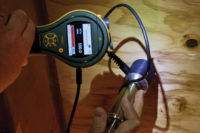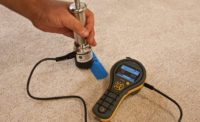If These Walls Could Talk…
The lessons learned in a flood house are the lessons that can change your business for the better








Many of you have gone to a hands-on drying school at one time in your career. There may be some vivid memories of what you learned while you took that course, there may be a few moments you wish you could forget, and hopefully you still remember your classmates you spent that week with. As an Applied Structural Drying instructor and the chairman of the IICRC ASD technical advisory committee, I have had the pleasure of meeting all of the instructors and being at most of the flood houses in our industry. The simple fact is, it is much easier to learn in the hands-on setting than in a classroom. The lessons learned in a flood house are the lessons that can change your business for the better.
Break our house, not the customers’…
The best reason for taking a hands-on class at a flood school is that you can try things on their house that you might be cautious of doing in your customers’ home or business. A great example of this is drying base trim in place. Restorers from all over the world share in the time honored tradition of tearing base trim out on every job. The reason is clear – “How can we dry behind base trim, and anyway, doesn’t mold always grow there?” In a hands-on flood school the students get to see what happens when base trim is dried in place.
I have taught or assisted with close to 250 ASD courses in my career so far, and here are the statistics: base trim dried = 248, base trim grew mold = 2. In both of the cases where there was a problem with drying behind the base trim, it was because the area was not monitored properly. We thought it was dry, but in reality it was still very wet.
Until a technician has had the experience of seeing that base trim can be dried in place in certain circumstances, they will be stuck with the procedure of always pulling trim. This costs your customers time and money, and cuts in to your profits. The training received at a hands-on flood school is priceless for this reason.
Flood house – fully networked
If your classes at a hands-on school have been anything like mine, you learn during class AND on break. The students attending these classes are generally the cream of the crop in their local businesses. When you get good students having good conversations about drying and restoration – magic happens.
I often see students working through different issues during the hands-on exercises in the flood house and on breaks. Tossing around “what-ifs” and “whys” is one of the best reasons to come to class.
Lately in my classes, the students have been working together on getting the best airflow from the different airmover technologies available. They are finding that axial type airmovers are covering a larger surface area at a slower velocity, while centrifugal airmovers cover a more narrow area at a higher speed. In my most recent class the students discovered that a low profile airmover placed on its side would direct the most air around an inside corner of a room. These kinds of innovations occur when you work side-by-side with motivated, intelligent people.
Measure accurately
Of all the exercises that can be done in a flood house, the most useful is moisture and air documentation. Psychrometric readings can be confusing in a water loss, and the application in a real life situation helps the students understand the process more completely.
Air and surface temperature readings describe the drying conditions most completely. Many students arrive at class with the conception that the only thing that matters is grains per pound – and each day it should go lower. Imagine the shock when the GPP stays relatively high throughout the course, and the materials still dry! The lesson learned is that surface temperature, gpp (vapor pressure) and relative humidity are all important in the process and indicate the quality of the drying environment.
Moisture documentation can be very frustrating in a hands-on drying school, which is exactly what can happen in real life. Often, several students are monitoring the same area and getting different results. Two equally qualified people taking a reading in the same location and one says the area is dry, and the other says it is still wet. The issue can normally be traced back to one of three things:
- Was it the same location?
- Was it the same meter?
- Was it the same meter setting?
On actual water losses, this is a big issue as well. Tracking the locations, meter and setting properly is a key to showing daily progress and that the structure actually dried.
One other aspect of monitoring in a hands-on flood school is a philosophical difference between air and moisture readings. I always find it fascinating that as an instructor, I have to spend hours explaining and working with the students on air readings, while only spending short times analyzing moisture readings. Moisture readings are easier to understand because each day we want the readings to go down, and eventually reach dry standard. Moisture readings are the most important readings, and they are easier to understand!
Random acts of… randomness
I teach most of my hands-on courses in Tennessee. During the summer, our weather is hot and humid – aka – boring! During the fall, winter and spring, our weather is ever changing – aka exciting! Your weather is the same way, and I wonder if you are taking advantage of the outside air to dry? Fall, winter and spring, I would lay odds that you can use the outside air quite a bit. Look for opportunities to temporarily ventilate your projects with dry air. It’s always fun in a hands-on course when it is about 40° F and raining outside – and the class discovers that the GPP outside is still less than the affected area. What a strange sight to see the windows open (slightly!) on a cold rainy day and it is helping the drying condition.
Isn’t that how a real water loss is? Random things are happening all the time – customers turning off equipment, breakers popping, weather changing, adjusters adjusting! A good hands-on school is going to allow some of these problems and opportunities to come up, and let the students find a solution.
Make it your class
I’m a huge fan of hands-on drying schools. If you haven’t been in a while, you should go back. Each time I go, I learn something new, or see it in a new way. If you approach the class with a great attitude, you should have a great experience, and it will change the way you dry structures.
Looking for a reprint of this article?
From high-res PDFs to custom plaques, order your copy today!










